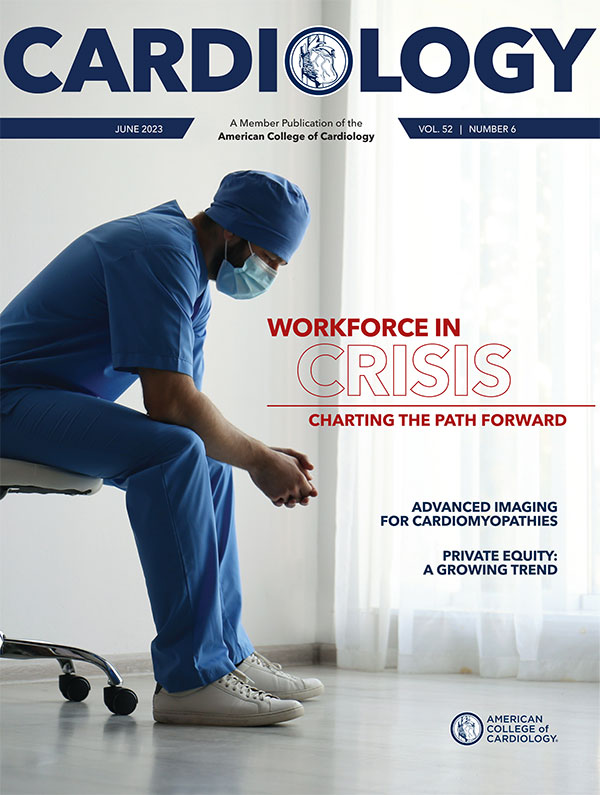Quality Improvement For Institutions | Informing Practice, Improving Outcomes With NCDR's Real-World Data

ACC's NCDR suite of registries is a robust source of data for researchers, and a critical component in continuing to help hospitals, practices and clinicians advance the quality of cardiovascular care and improve patient outcomes for all.
The real-world evidence from recent NCDR research provides insights into transcatheter left atrial appendage occlusion (LAAO) and the safety of the Watchman FLX device as well as post procedure pericardial effusion. Other studies leveraging NCDR data have shown weight predicts outcomes after ablation in pediatric patients with Wolff-Parkinson-White syndrome; high procedural success with low complication rates with ablation for atrial fibrillation (AFib); and PCI for chronic total occlusion (CTO) is associated with a higher risk of adverse events.
Read on and then share your thoughts about the findings on Twitter using #NCDR and #CardiologyMag or join in discussions on the ACC's LinkedIn page.
Click here to bookmark the registry news page to keep up with the clinical insights from NCDR research.
Pericardial Effusion Post Transcatheter LAAO: Infrequent, Associated With Higher Risk of Adverse Events
In-hospital pericardial effusion as a complication of transcatheter LAAO was found to occur infrequently but was associated with a higher risk of adverse events, according to a study published in Circulation: Cardiovascular Interventions.
Matthew J. Price, MD, FACC, et al., examined data from 65,355 patients (mean age 76.2±8.1, mean CHA2DS2-VASc score 4.6±1.5) captured by the LAAO Registry who underwent a transcatheter LAAO procedure using the first-generation Watchman device between Jan. 1, 2016 and Dec. 31, 2019.
The primary outcome of incidence of in-hospital pericardial effusion requiring intervention via percutaneous drainage or surgery occurred in 1.35% of patients.
Clinical variables independently associated with in-hospital pericardial effusion were older age, female sex, left ventricular function, paroxysmal AFib, prior bleeding, lower serum albumin and preprocedural dual antiplatelet therapy. Procedural variables associated with in-hospital pericardial effusion included number of delivery sheaths, sinus rhythm during the procedure and moderate sedation rather than general anesthesia.
When analyzing the risk of adverse events, researchers found in-hospital pericardial effusion was associated with a greater risk of in-hospital stroke (odds ratio [OR], 6.58; 95% CI, 3.32-13.06; p<0.0001), death (OR, 56.88; 95% CI, 39.79-81.32; p<0.0001) and the composite of death, stroke or systemic embolism (OR, 28.64; 95% CI, 21.24-38.61; p<0.0001). Pericardial effusion during the index hospitalization was also associated with increased risk between discharge and 45-day follow-up for death (OR, 3.52; 95% CI, 2.23-5.54; p<0.0001) and the composite endpoint (OR, 3.42; 95% CI, 2.31-5.07; p<0.0001).
"Periprocedural [pericardial effusion] after transcatheter LAAO is infrequent but associated with substantially increased risk of adverse events, including stroke and both in-hospital and early post-discharge mortality," write the study authors. "Strategies to minimize [pericardial effusion], potentially guided by an understanding of the associated patient and procedural risk factors, will be critical to improve the risk-benefit ratio for this therapy."
ACC Quality Summit 2023: Save the Date!
Mark your calendar for Oct. 11-13 and plan to be in Orlando, FL, for this year's Quality Summit. Click here to learn more.
CTO PCI vs. non-CTO PCI?
CTO PCI was associated with a higher risk of adverse events both in-hospital and out-of-hospital compared with non-CTO PCI according to study results published in JSCAI.
Zaid Almarzooq, MBBcH, MPH, FACC, et al., looked at data from 551,722 Medicare patients captured by the CathPCI Registry from July 2009 to December 2016, where 29,407 patients underwent CTO PCI and 522,315 non-CTO PCI. They also compared outcomes in the CTO PCI patients and the 53,662 non-CTO patients considered at high risk. Patients with STEMI and NSTEMI were excluded.
Results revealed that patients undergoing CTO PCI were more likely to be younger (mean age, 73.7) and male (69.5%), with a higher risk of in-hospital events when compared to both non-CTO PCI (7.0% vs. 4.2%; p<0.001) and high-risk non-CTO PCI (7.0% vs. 6.5%; p=0.008). CTO PCI was also associated with a higher risk of long-term repeat revascularization compared with non-CTO PCI (adjusted hazard ratio [aHR], 1.09; 95% CI, 1.05-1.13).
When comparing high-risk non-CTO PCIs, researchers did note a slightly lower risk in CTO PCI patients for long-term major adverse cardiovascular events and readmission (aHR, 0.87; 95% CI, 0.84-0.90 for both).
"In this large national cohort of patients undergoing PCI, we found that patients undergoing CTO PCI experienced lower procedural success rates and higher adverse events during the index hospitalization," Almarzooq, et al., write. "These differences were less evident when comparing CTO PCI with high-risk non-CTO PCI and varied across the subgroups of high-risk non-CTO PCI."
Weight as Predictor of Ablation Outcomes in Pediatric Wolff-Parkinson-White Syndrome
Weight <30 kg was found to be an independent predictor of acute success for patients with pediatric Wolff-Parkinson-White syndrome undergoing catheter ablation, and associated with a small yet elevated risk of major adverse events, according to study results published in JACC: Clinical Electrophysiology.
Christopher M. Janson, MD, et al., evaluated 4,456 cases from 84 centers captured by the IMPACT Registry, with 14% weighing <30 kg. They found that patients weighing <30 kg were more likely to have preprocedural supraventricular tachycardia (SVT) (45% vs. 29%; p<0.001) and more likely to have right septal accessory pathways (25% vs. 33%; p<0.001). While major adverse events were ultimately rare, a higher rate was identified among the <30 kg cohort (0.3% vs. 0.05%; p=0.04).
Researchers noted no significant difference in the likelihood of deferred ablation between those weighing <30 kg and the rest of the participants (9% vs. 12%; p=0.07) or use of cryoablation (11% vs. 11%; p=0.70) and ablation success was higher in the <30 kg cohort (95% vs. 92%; p=0.009), even after adjusting for accessory pathway type, location and ablation energy source using multivariable modeling. Use of radiofrequency and cryo catheters and non–left-free wall pathway locations were associated with ablation failure.
Janson, et al., write that "although [they] expected patient weight to affect intraprocedural decisions and outcomes, [their] analysis suggests that a significant source of variation occurs before the procedure, in patient selection at referral for ablation." This referral bias led to a higher proportion of patients <30 kg being symptomatic, exhibiting documented SVT and taking medications.
Overall, despite the variation in decision to refer for electrophysiology study, weight <30 kg remained an independent predictor of acute procedural success, with anatomic factors likely playing a role in greater success in smaller patients. This success comes at the cost of higher rates of major adverse events.
AFib Ablation Registry: Five Year Outcomes
The majority of AFib ablation procedures result in successful pulmonary vein isolation with low complication rates, according to a study published in JACC examining the first five years of data collected by the NCDR AFib Ablation Registry.
Jonathan Chong Hsu, MD, FACC, et al., analyzed a total of 76,219 patients (mean age 65.5±10.3 years, 65.2% male, 55.8% paroxysmal AFib, CHA2DS2-VASc score 2.7±1.6) captured by the registry from January 2016 to December 2020. They found that successful isolation of all pulmonary veins was established in 92.4% of patients, while complication rates were low overall.
Additionally, the rate of any complication during procedural admission was 2.5%, while the rate of a major complication was 0.9%. Major complications included significant bradycardia (0.47%), heart failure (0.47%) and pericardial effusion requiring intervention (0.44%). In-hospital death was rare (n=41, 0.05%), and hospitalization greater than one day occurred in 11.8% of patients.
This first analysis of data from the AFib Ablation Registry mainly centered on taking stock of patient, hospital and physician characteristics, along with in-hospital AFib ablation outcomes. Moving forward, the study authors emphasize the value of this dataset for future inquiry, including the ability to "assess practice trends, evaluate treatment patterns associated with different patient outcomes, and support development of evidence-based guidelines."
In an accompanying editorial comment, Matthew R. Reynolds, MD, FACC, and Javaria Ahmad, MD, note the limitations of studies based on registry data but recognize the positives associated with the detail and scale of the AFib Ablation Registry.
"The AFib Ablation Registry has notable strengths, including a detailed data collection form that provides far richer clinical detail than insurance claims…the data are likely to be accurate, though some under-reporting of adverse events may still be possible," they state. "Perhaps most importantly, the registry has the advantage of scale, by 2020 collecting more than 10-times more records than any previous prospective AFib ablation registry."
Next Generation Watchman FLX Devices Safer Than First Generation Watchman For Transcatheter LAAO
Transcatheter LAAO using the next generation Watchman FLX was linked to lower rates of in-hospital major adverse events when compared with the first generation Watchman device, according to study results published in JACC: Cardiovascular Interventions.
Matthew J. Price, MD, FACC, et al., used data from the LAAO Registry to examine outcomes in 27,013 patients who underwent Watchman FLX implantation and a control group of 27,013 patients who underwent Watchman 2.5 implantation.
Results showed the rate of in-hospital major adverse events – a composite of death, cardiac arrest, stroke, transient ischemic attack, intracranial hemorrhage, systemic arterial embolism, major bleeding, major vascular complication, myocardial infarction, pericardial effusion requiring intervention and device embolization – was significantly lower for the Watchman FLX device vs. the Watchman 2.5 device (1.35% vs. 2.40%; adjusted odds ratio [aOR], 0.57; 95% CI, 0.50-0.65; p<0.0001), mainly driven by fewer pericardial effusions requiring intervention (0.42% vs. 1.23%; aOR, 0.34; 95% CI, 0.28-0.42; p<0.0001).
The Watchman FLX was also associated with less in-hospital mortality (0.12% vs. 0.24%; p<0.0001), major bleeding (1.08% vs. 2.05%; p<0.0001), cardiac arrest (0.13% vs. 0.24%; p=0.006), and device embolization (0.02% vs. 0.06%; p=0.028). There was no significant difference between the two groups concerning myocardial infarction, stroke and major vascular complications.
Regarding study limitations, Price, et al., acknowledge the study only looked at in-hospital outcomes, and did not assess procedural complications such as late pericardial effusions.
According to investigators, "the substantially "the substantially lower rate of procedural complications with the Watchman FLX, including mortality, pericardial effusion, and major bleeding, may provide a safety advantage for transcatheter LAAO compared with medical therapy in patients at high bleeding risk." Longer-term follow-up is needed to determine the net clinical benefit, they said.
NCDR: Data Powering Performance
More than 2,000 facilities worldwide participate in one or more ACC's registries, forming a comprehensive network of cardiovascular care providers committed to ensuring evidence-based cardiovascular care, improving patient outcomes and lowering health care costs.
Click here to learn more about all the NCDR registries and become a participant.
Keywords: ACC Publications, Cardiology Magazine, Registries, National Cardiovascular Data Registries, LAAO Registry, IMPACT Registry, AFib Ablation Registry, CathPCI Registry, EP Device Implant Registry, Quality Improvement, Innovation
< Back to Listings

